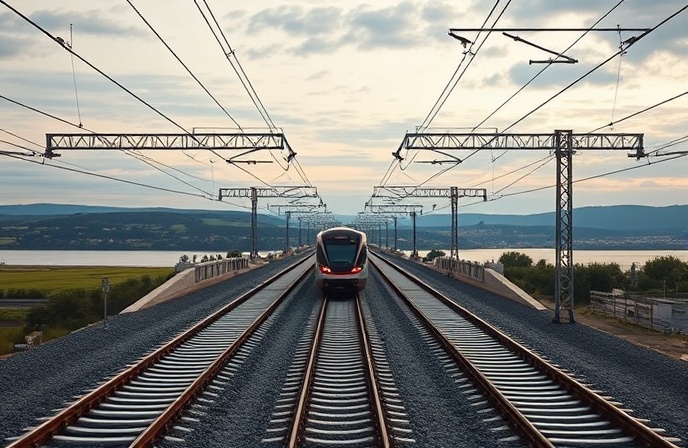Deutsche Bahn 2023: Losses, Investments, and Future Outlook

Deutsche Bahn’s 2023 Financial Performance: A Critical Analysis
This article delves into the financial results of Deutsche Bahn (DB), Germany’s national railway operator, for the year 2023. DB reported significant losses, primarily attributed to substantial infrastructure investments and external factors. While the company highlights increased passenger numbers and a large-scale modernization program, the analysis will explore the interplay between these positive developments and the negative financial impact, examining the underlying causes of the losses and evaluating the long-term implications of DB’s strategic decisions. The analysis will further explore the challenges faced by DB in balancing its ambitious infrastructure modernization goals with the need for financial stability and operational efficiency, considering the impact of external factors such as inflation and interest rate hikes. Finally, the article will assess the validity of DB’s optimistic outlook for 2024 and the long-term viability of its “Strong Rail” strategy in achieving Germany’s climate and transport objectives.
Massive Infrastructure Investments and Their Financial Impact
DB’s 2023 financial report reveals a net loss of €2.4 billion ($2.5 billion), a stark contrast to the €227 million loss in 2022. A significant contributor to this deficit is the €964 million ($1.04 billion) EBIT (Earnings Before Interest and Taxes) loss. DB attributes this primarily to substantial infrastructure investments, exceeding €1 billion pre-financed by the German government. While these investments are crucial for modernizing the rail network and improving long-term operational efficiency, they have resulted in immediate and considerable financial strain. The increased capital expenditure (CAPEX) directly contributes to the rise in net debt, further exacerbated by the significant increase in interest rates, forcing DB to borrow heavily to fund its expansion and modernization projects. This highlights the inherent tension between long-term strategic objectives and short-term financial performance.
Operational Challenges and Performance Metrics
Despite a 5.8% year-on-year increase in passenger numbers, reaching almost 2 billion journeys, DB’s operational performance suffered setbacks. Train path kilometers (the total distance traveled by trains) decreased by 1.3%, reflecting potential capacity constraints or operational inefficiencies. More concerning is the decline in on-time performance. Punctuality for long-distance services dropped to 64.0% from 65.2% in 2022, while regional services saw a similar, albeit smaller, decrease to 91.0% from 91.8%. DB attributes these declines to high network capacity utilization coupled with extensive ongoing construction work. This underlines the challenges of balancing modernization and maintaining consistent operational efficiency during significant infrastructure upgrades.
External Factors and Cost Pressures
DB’s financial difficulties are not solely attributable to internal factors. The company explicitly points to the considerable impact of external pressures, including inflation and strikes. Inflation-driven cost increases across various operational aspects, coupled with substantial personnel expense increases, further strained DB’s finances. Additionally, the sharp rise in interest rates significantly increased the cost of borrowing, exacerbating the financial burden of its infrastructure investments. These factors underscore the vulnerability of railway operators to macroeconomic conditions and the importance of robust financial planning in navigating fluctuating economic environments.
The “Strong Rail” Strategy and Future Outlook
DB CEO Richard Lutz emphasizes that the 2023 losses were anticipated and represent a necessary investment in the future. He highlights the commencement of a major €30 billion ($32 billion) capital expenditure program, the largest since the 1994 German Rail Reform, funded largely by the German government. This program is central to DB’s “Strong Rail” strategy, aimed at modernizing the nation’s rail infrastructure and achieving Germany’s climate and transport policy objectives. Lutz’s optimistic outlook for 2024 suggests that the substantial investments made in 2023 will yield positive returns in the coming years. However, the long-term success of this strategy hinges on several factors including effective project management, efficient resource allocation, successful mitigation of operational challenges during the upgrade process, and continued governmental support in navigating fluctuating economic conditions. The successful implementation of the “Strong Rail” strategy will be crucial not only for DB’s financial recovery, but also for Germany’s broader sustainability and transportation goals.
Conclusions
Deutsche Bahn’s 2023 financial results reveal a complex picture. While passenger numbers increased significantly, the company reported substantial losses driven by massive infrastructure investments, external factors like inflation and rising interest rates, and operational challenges affecting punctuality. The €1 billion+ investment in infrastructure improvements, while essential for long-term modernization and increased efficiency, created immediate financial strain, exacerbated by macroeconomic conditions. The decrease in on-time performance, though explained by ongoing construction, raises concerns about the operational efficiency during periods of significant infrastructure upgrades. The company’s “Strong Rail” strategy, fueled by a large government-funded investment program, presents a pathway towards improved long-term performance and achievement of Germany’s climate goals. However, the success of this ambitious plan hinges on effective project management, careful cost control, mitigating operational disruptions during the upgrade phase, and continued government support in mitigating the effects of unpredictable economic cycles. The coming years will be critical in determining whether DB can successfully navigate these challenges and deliver on its ambitious vision for the future of German rail.



